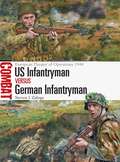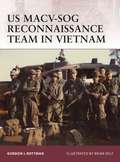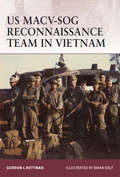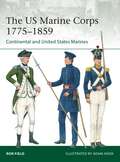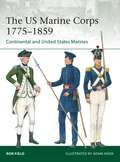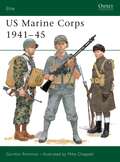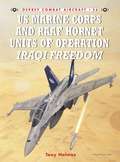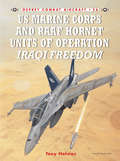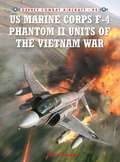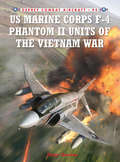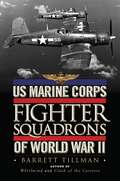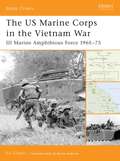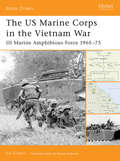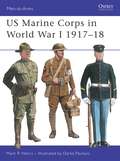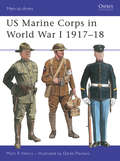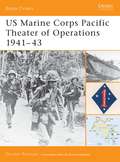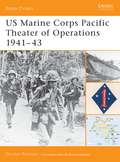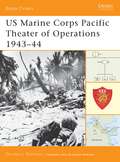- Table View
- List View
US-Indian Strategic Cooperation into the 21st Century: More than Words (Asian Security Studies)
by Sumit Ganguly Brian Shoup Andrew ScobellIn this edited book, leading scholars and analysts trace the origins, evolution and the current state of Indo-US strategic cooperation. During the Cold War, owing to opposing grand strategies, the two states frequently found themselves at odds. With the end of the Cold War and the demise of the Soviet Union, Indo-US security cooperation started in a fitful fashion, but in recent years it has acquired considerable stability. The armed forces of the two states have participated in exercises on land, sea and air and have also carried out joint humanitarian missions. Drawing on new information and with contributions from both academics and policy makers, this wide-ranging volume analyzes the strategic convergence of the world’s two largest democracies, whilst explaining why important differences do remain. These notably include questions pertaining to the future of India’s nuclear and ballistic missile programs, US-Pakistan ties and India’s links with Iran. This volume will be of great interest to students of South Asian politics, Asian security, US foreign policy and security studies in general.
US Infantryman in World War II: Pacific Area of Operations 1941–45 (Warrior #45)
by Robert S RushThis title deals with the experiences of the American soldiers who fought the Japanese across the Pacific islands, and the specific nature of this combat environment. It follows a hypothetical soldier, 'Michael', through his enlistment into and training with the 165th Infantry Regiment (New York National Guard). It takes him through the 1941 maneuvers the 27th Infantry Division participated in, the transfer to Oahu, and into the reality of daily life and combat in the Pacific theater from 1942 to 1945, including Makin, Saipan and Okinawa. It also looks at the PTO administrative procedures for replacements, and medical and psychiatric care of the ordinary soldier. Whilst the focus is on one individual, the experiences of the many are examined and woven into an intricate and meticulous narrative.
US Infantryman in World War II: Pacific Area of Operations 1941–45 (Warrior)
by Elizabeth Sharp Robert S RushThis title deals with the experiences of the American soldiers who fought the Japanese across the Pacific islands, and the specific nature of this combat environment. It follows a hypothetical soldier, 'Michael', through his enlistment into and training with the 165th Infantry Regiment (New York National Guard). It takes him through the 1941 maneuvers the 27th Infantry Division participated in, the transfer to Oahu, and into the reality of daily life and combat in the Pacific theater from 1942 to 1945, including Makin, Saipan and Okinawa. It also looks at the PTO administrative procedures for replacements, and medical and psychiatric care of the ordinary soldier. Whilst the focus is on one individual, the experiences of the many are examined and woven into an intricate and meticulous narrative.
US Infantryman vs German Infantryman: European Theater of Operations 1944 (Combat #15)
by Steven J. Zaloga Mr Steve NoonThe Allied airborne and amphibious landings on D-Day opened up the long-awaited Second Front against Nazi Germany, but after overcoming the German coastal defenses at Utah and "Bloody Omaha,†? the US Army found itself having to contest every hedgerow and street in a nightmarish battle of attrition. It was the humble infantrymen of both sides who would play a vital role in taking and holding key objectives. Battles across Europe tested both sides to the limit, from the close-quarters warfare around Cherbourg in June 1944 to the struggle for the Scharnhorst Line in October and the brutal cold-weather fighting in the Ardennes that December. Featuring full-color artwork, specially drawn maps, and archive photographs, this study offers key insights into the tactics, leadership, and combat performance of the US and German infantrymen pitched into three pivotal actions at the height of World War II.
US Infantryman vs German Infantryman: European Theater of Operations 1944 (Combat)
by Steven J. Zaloga Steve NoonThe Allied airborne and amphibious landings on D-Day opened up the long-awaited Second Front against Nazi Germany, but after overcoming the German coastal defenses at Utah and "Bloody Omaha,†? the US Army found itself having to contest every hedgerow and street in a nightmarish battle of attrition. It was the humble infantrymen of both sides who would play a vital role in taking and holding key objectives. Battles across Europe tested both sides to the limit, from the close-quarters warfare around Cherbourg in June 1944 to the struggle for the Scharnhorst Line in October and the brutal cold-weather fighting in the Ardennes that December. Featuring full-color artwork, specially drawn maps, and archive photographs, this study offers key insights into the tactics, leadership, and combat performance of the US and German infantrymen pitched into three pivotal actions at the height of World War II.
The US-Iran Relationship: The Impact of Political Identity on Foreign Policy (Library of International Relations)
by Penelope KinchSince the Revolution of 1978/79, which eventually brought to power Ayatollah Khomeini and his circle of conservative, though politically active, clerics, the relationship between Iran and the USA has represented one of the world's most complex and hostile international entanglements. In this book, Penelope Kinch analyses the extent to which political identity has contributed to challenges in the relationship and the role of myths in foreign policy. Kinch first examines the construction of political identity in each country, and thereby traces the imagined norms which have their impact on international behaviour.
US MACV-SOG Reconnaissance Team in Vietnam (Warrior)
by Gordon L. Rottman Brian DelfIn 1964 Military Assistance Command, Vietnam, activated a joint unconventional task force known as the Studies and Observation Group-MACV-SOG. As a cover its mission was to conduct analysis of lessons learned in combat by all branches of service. SOG's real mission was to conduct covert strategic reconnaissance missions into Laos, Cambodia and South Vietnam as well as sabotage and 'Black' psychological operations. Ground, air and naval assets were employed to insert, collect, extract, and otherwise support these operations. This book tells the complete story of these covert agents, from their recruitment and training, through to their deadly black-ops in the jungles of Vietnam.
US MACV-SOG Reconnaissance Team in Vietnam (Warrior #159)
by Gordon L. Rottman Brian DelfIn 1964 Military Assistance Command, Vietnam, activated a joint unconventional task force known as the Studies and Observation Group-MACV-SOG. As a cover its mission was to conduct analysis of lessons learned in combat by all branches of service. SOG's real mission was to conduct covert strategic reconnaissance missions into Laos, Cambodia and South Vietnam as well as sabotage and 'Black' psychological operations. Ground, air and naval assets were employed to insert, collect, extract, and otherwise support these operations. This book tells the complete story of these covert agents, from their recruitment and training, through to their deadly black-ops in the jungles of Vietnam.
The US Marine Corps 1775–1859: Continental and United States Marines (Elite)
by Ron FieldFeaturing specially commissioned artwork and archive illustrations, this engrossing study describes the US Marine Corps' early operations and illustrates its evolving uniforms and personal equipment. The US Marine Corps' uniforms, personal equipment, insignia, and weaponry are all described and illustrated in this book, complemented by a succinct history of the Marines' military record from their beginnings to the eve of the American Civil War, by which time the US Marine Corps had established itself as a small but vitally important part of the United States' armed forces. Organized in 1775, the first American Marines distinguished themselves throughout the American Revolutionary War, and even raided mainland Britain before being disbanded in 1783. Reestablished in 1798, the US Marine Corps fought in the Barbary Wars and the War of 1812, both at sea and on land. The years after 1815 saw the Corps involved in a wide variety of conflicts, from the Seminole Wars to the Mexican–American War; Marines even reached China and Japan. As the prospect of civil war began to threaten the United States, a small battalion of Marines was responsible for the capture of abolitionist John Brown at Harper's Ferry on October 18, 1859. The diverse operations and evolving appearance of the Marines are captured in this absorbing study from an acknowledged authority on US military costume.
The US Marine Corps 1775–1859: Continental and United States Marines (Elite)
by Ron FieldFeaturing specially commissioned artwork and archive illustrations, this engrossing study describes the US Marine Corps' early operations and illustrates its evolving uniforms and personal equipment. The US Marine Corps' uniforms, personal equipment, insignia, and weaponry are all described and illustrated in this book, complemented by a succinct history of the Marines' military record from their beginnings to the eve of the American Civil War, by which time the US Marine Corps had established itself as a small but vitally important part of the United States' armed forces. Organized in 1775, the first American Marines distinguished themselves throughout the American Revolutionary War, and even raided mainland Britain before being disbanded in 1783. Reestablished in 1798, the US Marine Corps fought in the Barbary Wars and the War of 1812, both at sea and on land. The years after 1815 saw the Corps involved in a wide variety of conflicts, from the Seminole Wars to the Mexican–American War; Marines even reached China and Japan. As the prospect of civil war began to threaten the United States, a small battalion of Marines was responsible for the capture of abolitionist John Brown at Harper's Ferry on October 18, 1859. The diverse operations and evolving appearance of the Marines are captured in this absorbing study from an acknowledged authority on US military costume.
US Marine Corps 1941–45 (Elite #59)
by Gordon L. RottmanWhile the US Marine Corps was one of the smallest of American armed services in World War II, its contribution to the final victory cannot be overstated. The US Marine Corps may have only comprised 5 percent of America's armed forces, but it suffered 10 percent of all World War II combat casualties. Above all, he amphibious nature of the war in the Pacific imposed on the Marine Corps greater tasks than any it had ever before been called upon to perform. This title details the organization, weapons and equipment of the US Marines of World War II.
US Marine Corps 1941–45 (Elite)
by Gordon L. Rottman Mike ChappellWhile the US Marine Corps was one of the smallest of American armed services in World War II, its contribution to the final victory cannot be overstated. The US Marine Corps may have only comprised 5 percent of America's armed forces, but it suffered 10 percent of all World War II combat casualties. Above all, he amphibious nature of the war in the Pacific imposed on the Marine Corps greater tasks than any it had ever before been called upon to perform. This title details the organization, weapons and equipment of the US Marines of World War II.
US Marine Corps and RAAF Hornet Units of Operation Iraqi Freedom (Combat Aircraft)
by Tony Holmes Chris DaveySome 84 of the 250 Hornets committed by Central Command to Operation Iraqi Freedom (OIF) proudly bore MARINE titling on their rear fuselages. A further 14 were marked with the distinctive kangaroo roundel of the Royal Australian Air Force (RAAF). The exploits achieved by the units that flew these jets into combat is detailed in this volume, the third of three titles published in the Combat Aircraft series on what has been dubbed by many TACAIR insiders the 'Hornet's War'. Although the bulk of this book deals with the major hostilities phase of OIF I, which ran from 20 March to 20 April 2003, the decade of pre-war OSW missions and ongoing post-war OIF II operations are also covered in significant detail from the Marine Corps perspective. Profusely illustrated with rare frontline photography and more than 30 specially commissioned colour artworks, this book also features the combat experiences of 24 pilots and Weapons Systems Officers.
US Marine Corps and RAAF Hornet Units of Operation Iraqi Freedom (Combat Aircraft)
by Tony Holmes Chris DaveySome 84 of the 250 Hornets committed by Central Command to Operation Iraqi Freedom (OIF) proudly bore MARINE titling on their rear fuselages. A further 14 were marked with the distinctive kangaroo roundel of the Royal Australian Air Force (RAAF). The exploits achieved by the units that flew these jets into combat is detailed in this volume, the third of three titles published in the Combat Aircraft series on what has been dubbed by many TACAIR insiders the 'Hornet's War'. Although the bulk of this book deals with the major hostilities phase of OIF I, which ran from 20 March to 20 April 2003, the decade of pre-war OSW missions and ongoing post-war OIF II operations are also covered in significant detail from the Marine Corps perspective. Profusely illustrated with rare frontline photography and more than 30 specially commissioned colour artworks, this book also features the combat experiences of 24 pilots and Weapons Systems Officers.
US Marine Corps F-4 Phantom II Units of the Vietnam War (Combat Aircraft)
by Jim Laurier Peter E. DaviesTwenty-five US Marine Corps squadrons flew versions of the Phantom II and 11 of them used the aircraft in South-East Asia from May 1965 through to early 1973. Rather than the air-to-air missiles that were the main component in the original F-4 armament, these aircraft carried an ever-expanding range of weaponry. Some toted 24,500-lb bombs and others strafed with up to three 20 mm gun pods, while most flew daily sorties delivering napalm, Snakeye bombs and big Zuni rockets. Many US Marines holding small outpost positions in Laos and South Vietnam against heavy Viet Cong attack owed their lives to the Phantom II pilots who repeatedly drove off the enemy. The book will examine these missions in the context of US Marine Corps close-support doctrine, using the direct experience of a selection of the aircrew who flew and organised those missions.
US Marine Corps F-4 Phantom II Units of the Vietnam War (Combat Aircraft #94)
by Jim Laurier Peter E. DaviesTwenty-five US Marine Corps squadrons flew versions of the Phantom II and 11 of them used the aircraft in South-East Asia from May 1965 through to early 1973. Rather than the air-to-air missiles that were the main component in the original F-4 armament, these aircraft carried an ever-expanding range of weaponry. Some toted 24,500-lb bombs and others strafed with up to three 20 mm gun pods, while most flew daily sorties delivering napalm, Snakeye bombs and big Zuni rockets. Many US Marines holding small outpost positions in Laos and South Vietnam against heavy Viet Cong attack owed their lives to the Phantom II pilots who repeatedly drove off the enemy. The book will examine these missions in the context of US Marine Corps close-support doctrine, using the direct experience of a selection of the aircrew who flew and organised those missions.
US Marine Corps Fighter Squadrons of World War II (General Military Ser.)
by Barrett TillmanThe US Marine Corps has a long heritage of aviation excellence, a reputation that was largely built on the impact and performance of the "flying leathernecks†? in the bitter fighting in the Pacific during World War II. As the US island-hopping campaign against Japan gathered pace, US Marine Corps fighter squadrons operating legendary Grumman and Vought aircraft became instrumental in the success of amphibious assaults and in breaking fierce enemy resistance, engaging Japanese attack aircraft in the skies and ground-based targets while supporting and protecting US ground forces. The flying legends Marion Carl, Greg "Pappy†? Boyington, Joe Foss and others were all World War II Marine fighter pilots, taking to the skies in Corsairs, Wildcats, Venturas and Hellcats. Aviation historian Barrett Tillman's comprehensive account US Marine Corps Fighter Squadrons of World War II pays homage to these individuals and their mounts, and is packed with historic and organizational details of the squadrons who took to the skies above the Pacific.
US Marine Corps Fighter Squadrons of World War II
by Barrett TillmanThe US Marine Corps has a long heritage of aviation excellence, a reputation that was largely built on the impact and performance of the “flying leathernecks” in the bitter fighting in the Pacific during World War II. As the US island-hopping campaign against Japan gathered pace, US Marine Corps fighter squadrons operating legendary Grumman and Vought aircraft became instrumental in the success of amphibious assaults and in breaking fierce enemy resistance, engaging Japanese attack aircraft in the skies and ground-based targets while supporting and protecting US ground forces. The flying legends Marion Carl, Greg “Pappy” Boyington, Joe Foss and others were all World War II Marine fighter pilots, taking to the skies in Corsairs, Wildcats, Venturas and Hellcats. Aviation historian Barrett Tillman's comprehensive account US Marine Corps Fighter Squadrons of World War II pays homage to these individuals and their mounts, and is packed with historic and organizational details of the squadrons who took to the skies above the Pacific.
The US Marine Corps in the Vietnam War: III Marine Amphibious Force 1965–75 (Battle Orders)
by Ed GilbertIII Marine Amphibious Force was conceived as a division command for a small Marine Corps commitment to Vietnam. Within four years it had grown to a reinforced corps of two divisions, an air wing, and the division-sized Force Logistics Command. This organization was unique in Marine Corps history in that it merged combat and major logistical functions under a single field command. This book examines the origins and constantly changing organizational structure of III MAF, and demonstrates how it conducted its savage struggle against Viet Cong guerrillas and North Vietnamese Army regular forces in the northern provinces of Vietnam.
The US Marine Corps in the Vietnam War: III Marine Amphibious Force 1965–75 (Battle Orders)
by Ed GilbertIII Marine Amphibious Force was conceived as a division command for a small Marine Corps commitment to Vietnam. Within four years it had grown to a reinforced corps of two divisions, an air wing, and the division-sized Force Logistics Command. This organization was unique in Marine Corps history in that it merged combat and major logistical functions under a single field command. This book examines the origins and constantly changing organizational structure of III MAF, and demonstrates how it conducted its savage struggle against Viet Cong guerrillas and North Vietnamese Army regular forces in the northern provinces of Vietnam.
US Marine Corps in World War I 1917–18 (Men-at-Arms)
by Darko Pavlovic Mark HenryThough the US Marines initially struggled to maintain their distinctive identity within the huge American Expeditionary Force in France, their unforgettable performance at Belleau Wood, Soissons, St Mihiel, Blanc Mont and the Meuse-Argonne established their reputation as 'the most aggressive body of diehards on the Western Front'. This book describes the organization of this formidable force from 1917-18 and details their uniforms, insignia and decorations, weapons and equipment. Numerous photographs and eight full colour plates vividly depict the various ranks of the US Marine Corps.
US Marine Corps in World War I 1917–18 (Men-at-Arms)
by Darko Pavlovic Mark HenryThough the US Marines initially struggled to maintain their distinctive identity within the huge American Expeditionary Force in France, their unforgettable performance at Belleau Wood, Soissons, St Mihiel, Blanc Mont and the Meuse-Argonne established their reputation as 'the most aggressive body of diehards on the Western Front'. This book describes the organization of this formidable force from 1917-18 and details their uniforms, insignia and decorations, weapons and equipment. Numerous photographs and eight full colour plates vividly depict the various ranks of the US Marine Corps.
US Marine Corps Pacific Theater of Operations 1941–43 (Battle Orders)
by Gordon L. RottmanThe outbreak of World War II set in motion a massive expansion of the United States Marine Corps, leading to a 24-fold increase in size by August 1945. This book is the first of several volumes to examine the Corps's meteoric wartime expansion and the evolution of its units. It covers the immediate pre-war period, the rush to deploy defense forces in the war's early months, and the Marines' first combat operations on Guadalcanal, New Georgia, and Bougainville. It focuses on the 1st, 2d, and 3d Marine Divisions (MarDivs) and the provisional 1st, 2d, and 3d Marine Brigades (MarBdes).
US Marine Corps Pacific Theater of Operations 1941–43 (Battle Orders #1)
by Gordon L. RottmanThe outbreak of World War II set in motion a massive expansion of the United States Marine Corps, leading to a 24-fold increase in size by August 1945. This book is the first of several volumes to examine the Corps's meteoric wartime expansion and the evolution of its units. It covers the immediate pre-war period, the rush to deploy defense forces in the war's early months, and the Marines' first combat operations on Guadalcanal, New Georgia, and Bougainville. It focuses on the 1st, 2d, and 3d Marine Divisions (MarDivs) and the provisional 1st, 2d, and 3d Marine Brigades (MarBdes).
US Marine Corps Pacific Theater of Operations 1943–44 (Battle Orders #7)
by Gordon L. RottmanBy January 1944 the US Marine Corps had grown to a total of 405,169 personnel, comprising 28,193 officers, 10,723 officer candidates, and 366,353 enlisted men. The Fleet Marine Force now had two amphibious corps, four divisions, a separate infantry regiment, 19 defense battalions, and numerous support and service units. Following on from Battle Orders 1: USMC in the Pacific Theater of Operations 1941–43, this book examines the continuing development of the Corps's organization, its training, tactics, weaponry, and command structure, as well as the battles fought in the Southwest Pacific on New Britain, and in the Central Pacific on Tarawa, Roi-Namur, Eniwetok, Saipan, and Tinian. The organization of the 4th Marine Division (MarDiv) and III and V Amphibious Corps (IIIAC, VAC) is also discussed along with smaller, new units.



